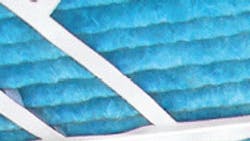The Essentials of Clean Room Maintenance
By Robert E. Monaghan, P.E.
Photo 1. In cleanrooms, prefilters (shown at left) are designed protect bag filters.
Photo 2. Bag filters shown with prefilters removed.
Photo 3. Sturdy box filters can be used to handle harsh environmental conditions.
Whether it's a biotechnology or a semiconductor application, regular and proper HVAC preventive maintenance on clean rooms is absolutely critical.
Depending on that application, one of several classes of clean rooms can be specified. This, in turn, will determine the amount of the room's needed filtration and air changes. These classes are shown in Table 1. Since all clean rooms run 24 hours a day/ 7 days a week, typical maintenance tasks can be separated into two parts: filter maintenance and equipment maintenance.
Filter Maintenance
Filter maintenance is a key part of clean room support and critical to keep the room within specification. The 24/7 operation of the room puts continuous flow through the filters, causing them to foul faster than equipment that runs on a time schedule.
All clean rooms use HEPA filters for the final cleaning of the conditioned air into the space. These are usually preceded by high-density (magnehelic metered) bag (or box) filters, which are then preceded by pre-filters.
Because HEPA filters are expensive and timeconsuming to replace, it's imperative to be diligent in the maintenance of the bag (or box) filters that protect them. Since the bag (or box) filters are somewhat expensive as well, it's also important to frequently replace the pre-filters that protect the bag (or box) filters.
A typical minimum filter replacement schedule for a clean room could be the following:
- Pre-filters — Six times per year
- Bag filters — One time per year
- HEPA filters — Once every three years.
This schedule may need to be adjusted for any particular clean room, as a result of the percentage of outside air that's introduced into the system, as well as the geographic or physical location of the building.
Often, the frequency of changes is influenced by nearby construction, proximity to freeways, as well as fog or other climate-related conditions.
For example, in one of our biotech clean room projects, we originally specified prefilters (photo 1), which protect the bag filters (photo 2).
However, because the building was next to a freeway, it was subjected to dust and debris. It was also next to commuter railroad tracks, where diesel smoke was a constant issue. To add yet another factor, the climate was very foggy. To counter all of these factors, we upgraded the bag filters to a box type (photo 3).
When quoting the maintenance for this building, we only included the prefilters on the bi-monthly changes, with the post filters being changed on an as-needed basis extra to the contract. This was also due to the fact that we didn't yet know the personality of the building.
Equipment Maintenance
Maintenance on any non-redundant clean room equipment will usually require a planned shutdown. This allows a technician the time necessary to thoroughly inspect such things as the belts, sheaves, and bearings.
It's a good idea to keep a spare parts inventory on hand so replacement of a worn belt or contactor can be accomplished without a subsequent interruption to the operation of the room.
The frequency of this work is best scheduled with the pre-filter maintenance, but is often times dictated by the clean room's restrictions.
Some Final Thoughts
The key to providing maximum reliability with a minimum of shutdowns is a good preventive maintenance program.
The first year of a clean room maintenance contract will usually reveal the personality of a particular building in both filter and equipment frequencies.
Monitoring how dirty the pre-filters are during service, and the changes in magnehelic readings on the bag (or box) filter housings, will ultimately determine the actual frequency of the filter changes.
In addition, working closely with the occupants of the clean room, as well as the facilities personnel, will help you discover the needed frequency of the equipment maintenance.
Robert E. Monaghan, P.E., is executive vice president at Western Allied Mechanical, Menlo Park, CA. He can be reached at 650/326-8290 or by e-mail at [email protected].
Table 1 - Clean Room Classes | ||
| Recommended Air Change Rate | Recommended % Ceiling Coverage for HEPA | |
| Class 100,000 | 20-30 | NA |
| Class 10,000 | 45-60 | 10-12% |
| Class 1,000 | 90 | 25-30% |
| Class 100 | 180 | 50-60% |
| Class 10 | 360 | 100% |
| Class 1 | 600+ | 100% |
